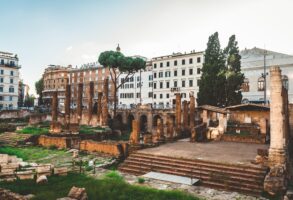
Published November 14, 2022
Decades into the Left’s obsession with rewriting America’s history as a tale of unrelieved oppression, we’re still being told that the dark side of our national story is under-taught. It isn’t only the 1619 Project that has falsely flipped America’s narrative on its head. America’s story as an oppression narrative — and very little else — is well on its way to being enshrined in blue state education standards, and in the College Board’s latest misbegotten venture as well.
But what if the real missing link in America’s history is the fuller story of how we became good — how we overcame an ancient oppression and extended the benefits of republican citizenship to all? That is the thesis of historian Jon K. Lauck’s new book, The Good Country: A History of the American Midwest, 1800–1900. (I met Lauck while researching education issues in his home state of South Dakota and so received an advance copy of his book.)
To begin with, Lauck’s book is the first general history of the 19th-century American Midwest. As such, The Good Country cements Lauck’s place as the leader of a group of scholars working to establish the study of our history’s most neglected region — the Midwest — as a bona fide historical sub-field. Yet The Good Country is more than local color. In tracing our history from a Midwestern perch, Lauck opens up a whole new angle — actually, several new angles — on America’s core narrative.
For a visual sense of the Midwestern gap in our history, have a look at pictures of America’s presidents, in order. Notice the run of mostly Republican presidents who followed Grant in the latter half of the 19th century, little-known figures such as Rutherford B. Hayes. This collection of bewhiskered, Republican, Union-veteran presidents from the Midwest is often stereotyped as monotonous and forgettable, at best, weak and inept, at worst. Renowned liberal historian Richard Hofstadter once dismissed these men as presidents “famous for their obscurity” about whom “not much need be said.”
Notoriously, however, Hofstadter and his fellow New York intellectuals were filled with disdain for Christianity, disdain for the provinces, disdain for small-town life, and disdain for the American version of Victorian morality that typified the Midwest in the 19th century. That hydra-headed disdain is Lauck’s target in The Good Country.
The antebellum gestation within the Midwest of what would become Lincoln’s Republican Party holds a story that is not well known, though it should be. It’s a story of the slow and difficult yet steady overcoming of slavery and associated prejudices. It’s the story of the cultural shift that made Lincoln and his party possible.
And strange as it may sound to modern ears, the Christian faith and Victorian moral stance of America’s Midwestern “squares” were very much a part of that story. Nowadays, the cultural powers that be claim that we can fight prejudice and also set our policy compass without the help of traditional Christian morality. Yet that remains an open question, one we can begin exploring with a look at the Midwest’s struggle with slavery.
The historical puzzle of our time goes something like this. Given the Founders’ understanding of human freedom, how could they have tolerated, much less practiced slavery? An important part of any reply to that question should be that slavery was a constant of global human history until the era when the Founders began to challenge it. (Many students nowadays mistakenly believe that slavery was a uniquely American institution.) Slavery’s historical omnipresence, in turn, raises a less common but equally fundamental question: How did America finally turn against slavery and end it?
The answer is less obvious than it seems. Yes, the American Founding, rooted in liberty and equality, initiated a process that brought slavery to an end, but what exactly was that process? The Civil War — overtly, at first, a war to preserve the Union — ultimately became a war to end slavery. But what gave Americans the will to fight such a war? Lincoln’s election as president precipitated the war, and Lincoln ultimately issued the Emancipation Proclamation. But what produced Lincoln and his anti-slavery party in the first place? History as currently taught fails to supply adequate answers to these questions.
Consider America’s History, by James A. Henretta, Eric Hinderaker, Rebecca Edwards, and Robert O. Self, one of the most widely used and widely touted textbooks conformed to framework of the College Board’s controversial 2014 AP U.S. History curriculum. Henretta’s discussion of abolitionism in the run-up to the Civil War accentuates the negative. We learn that abolitionism was shaped by Evangelical Christians, yet Henretta’s emphasis is on the weakness of abolitionism in the North, even among churchgoers. White mob violence against both white abolitionists and free Northern blacks is another Henretta theme. In Henretta’s telling, abolitionists come off as a tiny, besieged movement overwhelmed by a tidal wave of racial hatred, even in the North.
Eventually Henretta gets around to the rise of the Republican Party and its free-soil, anti-slavery stance. And of course, there’s the obligatory bow to the cultural impact of Uncle Tom’s Cabin. Even so, based on Henretta’s account, it’s tough to understand how the Republican Party emerged at all, much less how Lincoln and emancipation prevailed. And while Henretta is a bit more fashionable (i.e., more negative) than most, other AP U.S. History textbooks take largely the same approach.
Supposedly, the College Board’s revised AP U.S. History curriculum framework is more accurate because it incorporates the latest historical scholarship. But does it? It’s true that for decades historians have been filling out the depressing picture condensed by Henretta and other textbooks. Lauck, however, gives us a very different account of the same period — not by suppressing the negative but by attending to an important stream of scholarship largely ignored by the history profession’s currently dominant voices.
The conventional narrative of America’s battle against slavery features a three- or four-decade gap between the founding era and the rise of abolitionism in the 1830s. This is true for most accounts, not just the newer College Board–influenced textbooks. Lauck, however, helps fill that gap.
Focusing on the Midwest, Lauck reminds us of the importance of the Northwest Ordinance, the charter established by the Continental Congress to guide the settlement of what would become new American states north of the Ohio River. Thomas Jefferson’s initial draft of the Ordinance banned slavery in the Northwest Territories, a ban removed by the Continental Congress at first but reinstated in the law’s final iteration. Lauck restores a proper appreciation of the Northwest Ordinance’s impact during the early decades of the 19th century, something antebellum Americans understood very well. In 1830, for instance, Daniel Webster declared that the Ordinance had “fixed forever the character of the population” northwest of the Ohio River.
Yet the Northwest Ordinance’s impact was no simple matter. As the Northwest Territories applied for statehood and wrote constitutions through the early decades of the 19th century, they voted on whether to exclude slavery and on a series of other laws regarding the treatment of blacks. With full-fledged states no longer bound by the Ordinance’s anti-slavery clauses, those votes were heavily contested. Especially in states dominated at first by settlers from the South, oppressive “black laws” often passed. Yet the practical legacy and moral sway of the Northwest Ordinance kept slavery out of the Midwest, even when it could have been approved. And the prestige and memory of the Ordinance remained a force on the side of opponents of black laws for decades to come. Midwesterners knew this history well, and over time regional pride in the Ordinance and its legacy grew. The impact of the Northwest Ordinance on the fate of slavery in the Midwest became a major plank in Lincoln’s case against Stephen Douglas.
In 1823–24, well before the emergence of the Northern abolitionism featured in textbooks, Illinois saw the rise of what Lauck calls a “strong and influential anti-slavery movement.” The impetus was a statewide referendum that would have amended the Illinois constitution to allow slavery. Leading the anti-slavery forces was Governor Edward Coles, one of the most remarkable figures in American history. A wealthy Virginia plantation owner who’d been secretary to President James Madison, Coles abandoned Virginia for Illinois in order to free his slaves, one of the few American slaveowners to do so while alive. As governor, Coles embraced the anti-slavery cause and asked the Illinois legislature to repeal the state’s black laws as well. Between Coles’s leadership, the emergence of anti-slavery societies, and energized Evangelical voters across Illinois, the pro-slavery amendment was defeated in 1824 by 57 to 43 percent, in an election with nearly 80 percent turnout.
Edward Coles’s remarkable story is known to historians — three book-length scholarly studies of Coles have appeared in the past 15 years. Yet the broader public barely knows him. The recent biographies are largely ignored by scholars, as well. Coles’s story runs counter to the oppression narrative demanded by today’s progressive orthodoxy. Yet surely it ought to be widely taught.
Lauck shows that the Midwest’s struggle with slavery and discrimination holds many more such untold stories. The anti-black and anti-abolitionist mob actions that dominate current textbook accounts were real and important. They need to be taught, and Lauck rightly cites them. Yet the fuller story looks rather different from the one portrayed in textbooks. Relying on recent yet largely overlooked scholarship, Lauck shows that abolitionist preaching had a far greater effect on Midwestern attitudes than previously recognized. Indeed, over time, abolitionists learned how to use increasingly isolated instances of mob violence to turn public opinion their way. A big part of the story of those vigilante mobs is the way they were repudiated over time.
Lauck also highlights the repeal of many black laws, incremental steps toward the enfranchisement of blacks, and some remarkable stories of early black schooling in the Midwest — often fully integrated schooling. By 1860, a greater percentage of black children in Ohio attended school than in many large Eastern states. The Eastern bias of historical work on the anti-slavery movement has led scholars to miss much of this, as has the modern hunger for accounts that impugn America. Relying on yet another body of neglected scholarship, Lauck also uncovers a largely forgotten early civil-rights movement in the form of sweeping Midwestern laws and court decisions that favored equality between the races in the years following the Civil War.
Measured against contemporary standards, the 19th-century Midwest would still be found wanting, of course. As Lauck shows, however, on the issue of race, and in numerous other areas as well, in its day, the American Midwest stood at or near the head of the world in the progress of freedom, equality, and justice. Lauck rightly calls for proportionality in judgement, for balancing the good and decent in the Midwest’s history against the “wicked and profane.” In the end, as Lauck persuasively shows, the balance of judgement tilts in the Midwest’s favor.
But what of the old Midwest’s dreaded Victorianism? What of temperance crusaders breaking up bars with axes, and what of suffocatingly prudish small towns driving rebellious children to the liberation of city life? Think of Meredith Wilson’s Music Man and the women in its fictional “River City, Iowa,” who were outraged at the local librarian’s advocacy of “dirty books” (Chaucer, Rabelais, Balzac).
Lauck finds this portrait overdrawn. Victorian complaints were there, but so were real-life “Marian the Librarians.” Actual censorship was rare, and classic books, art, and literature were all the rage in the old Midwest. Religious skeptics went unmolested and in fact flourished. And libraries were everywhere. The ideal of an educated and democratic public culture took hold more deeply in the American Midwest than anywhere else in the world in the 19th century. Everything Tocqueville pointed to in America seemed to go double for the Midwest. The class divisions of the East and South were absent there, and schooling, hard work, reading, and self-improvement became the magical keys to advancement.
Lauck dives deeply into the biography of Carl Van Doren, Illinois native, The Nation’s early-20th-century book critic — the man more responsible than anyone for propagating the image of the Midwest as a stultifying and repressive hinterland. It was Van Doren who authored the “revolt from the village” thesis about suffocating middle-American small towns. As it turns out, however, Van Doren’s real problem was his happy childhood. By his own admission, happiness didn’t sell well among the literary set in New York. So Van Doren largely concocted his middle-American repression narrative.
Lauck argues that in our era of “callow tweets, sensationalism, celebrity worship, extreme loneliness . . . and rampant anxiety and depression devouring our young,” the old culture of the Midwest “deserves a second look, and not our condescension.” Although Lauck leans conservative, one of his models for this second look at traditional Christian morality is Christopher Lasch, who pops up in The Good Country and in a fascinating scholarly article by Lauck. Lasch was no friend of capitalism, yet he came to believe that true reform in America was impossible without the moral weight of traditional religion behind it. Lasch drew that lesson from his study of the Midwest, and so does Lauck.
In an era when climate protesters deface priceless art with raw food, the de facto religion of our day evidently lacks the moral weight to bring about reform — or to seek the right reform to begin with. Self-expressive protest as defacement of great art is a bizzarro parody of censorious Victorianism. I’ll take River City.
In short, Lauck’s Good Country turns the reigning progressive historical consensus upside down and gives it the thorough shaking it deserves. And Lauck does it, not by turning away from the underside of American history, but by uncovering truths to which today’s historian-ideologues remain willfully blind. The square, boring, long-overlooked 19th century Midwest turns out to be the missing link in American history, the piece that explains how we actually got from the Founding to Lincoln, and, sadly, the piece we cast aside several decades ago. The loss of that old-fashioned goodness may leave us wandering in the wilderness for some time.
Stanley Kurtz is a Senior Fellow at the Ethics and Public Policy Center. Beyond his work with Education and American Ideals, Mr. Kurtz is a key contributor to American public debates on a wide range of issues from K-12 and higher education reform, to the challenges of democratization abroad, to urban-suburban policies, to the shaping of the American left’s agenda. Mr. Kurtz has written on these and other issues for various journals, particularly National Review Online (where he is a contributing editor).
Stanley Kurtz is a Senior Fellow at the Ethics and Public Policy Center. Beyond his work with Education and American Ideals, Mr. Kurtz is a key contributor to American public debates on a wide range of issues from K–12 and higher education reform, to the challenges of democratization abroad, to urban-suburban policies, to the shaping of the American left’s agenda. Mr. Kurtz has written on these and other issues for various journals, particularly National Review Online (where he is a contributing editor).










